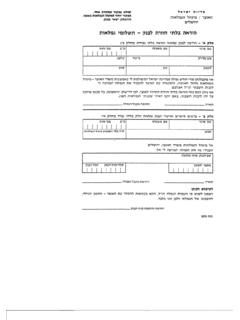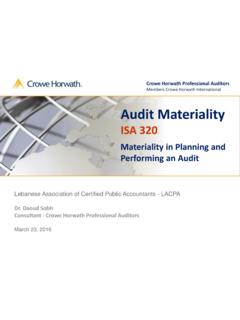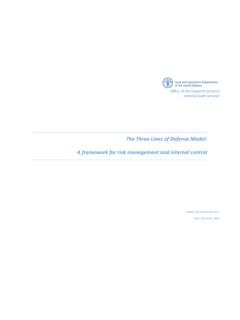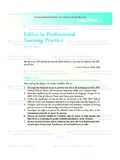Transcription of Corporate Governance – Boards of Directors of …
1 Consult this publication on line at work is published on the OECD iLibrary, which gathers all OECD books, periodicals and statistical for more :HSTCQE=V]\WX]:ISBN 978-92-64-18723-8 26 2013 01 1 PCorporate GovernanceBoards of Directors of State-Owned EnterprisesAN OVERVIEW OF NATIONAL PRACTICESC ontentsPrefaceExecutive summaryIntroductionChapter 1. The role of Boards of directorsChapter 2. Board nomination framework and practicesChapter 3. Board composition: Constraints and guidelinesChapter 4. Board training and inductionChapter 5. Board remunerationChapter 6. Boardroom efficiencyChapter 7. Board evaluationsBoards of Directors of State-Owned EnterprisesCorporate GovernanceCorporate GovernanceBoards of Directors of State-Owned EnterprisesAN OVERVIEW OF NATIONAL PRACTICESC orporate GovernanceBoards of Directorsof State-OwnedEnterprisesAN OVERVIEW OF NATIONAL PRACTICESThis work is published on the responsibility of the Secretary-General of the opinions expressed and arguments employed herein do not necessarily reflectthe official views of the Organisation or of the governments of its member document and any map included herein are without prejudice to the status ofor sovereignty over any territory, to the delimitation of international frontiers andboundaries and to the name of any territory, city or 978-92-64-18723-8 (print)
2 ISBN 978-92-64-20042-5 (PDF)The statistical data for Israel are supplied by and under the responsibility of the relevantIsraeli authorities. The use of such data by the OECD is without prejudice to the status of theGolan Heights, East Jerusalem and Israeli settlements in the West Bank under the terms ofinternational to OECD publications may be found on line OECD2013 You can copy, download or print OECD content for your own use, and you can include excerpts from OECD publications, databases and multimedia products in your own documents, presentations, blogs, websites andteaching materials, provided that suitable acknowledgment of the source and copyright owner is given. Allrequests for public or commercial use and translation rights should be submitted Requestsfor permission to photocopy portions of this material for public or commercial use shall be addressed directlyto the Copyright Clearance Center (CCC) the Centre fran ais d'exploitation du droit decopie (CFC) cite this publication as:OECD (2013), Boards of Directors of State-Owned Enterprises:An Overview of National Practices,OECD OF Directors OF STATE-OWNED ENTERPRISES: AN OVERVIEW OF NATIONAL PRACTICES OECD 20133 ForewordThis report provides practical guidance on board practices for Directors of state-owned enterprises and identifies a number of good practices based on nationalexperiences of a large number of participating countries.
3 It extends the guidanceprovided by Chapter VI of theOECD Guidelines on the Corporate Governance ofState-Owned Enterpriseson the Responsibilities of Boards of State-OwnedEnterprises . The report draws information from a questionnaire-based exercise aswell as previous publications and background papers commissioned by the Practices project on Enhancing the role of the Boards of Directors of state-owned enterprises . It was given final approval and declassified by the WP SOPP inDecember 2012. The draft report was prepared by Sara Sultan and Hans Christiansen ofthe Corporate Affairs Division of the OECD Directorate for Financial and Enterprise input was provided by Jim Colvin acting as external consultant to the development of the report has also benefited from comprehensive consultations withthe Business and Industry Advisory Committee (BIAC), the Trade Union AdvisoryCommittee (TUAC), civil society, academia and OECD partner OF CONTENTSBOARDS OF Directors OF STATE-OWNED ENTERPRISES: AN OVERVIEW OF NATIONAL PRACTICES OECD 20135 Table of 7 Acronyms and 9 Executive role of Boards of 21 Definingroles and 22 Conformance vs.
4 25 Adding 27 Chapter nomination frameworks and 29 Exercising the nomination and appointment 31 Identification and selection of board 33 The role of the Board in 38 The relationship with non-state 45 Chapter composition: Constraints and 47 Maintainingboard objectivity and 50 Employee representatives on the 53 Eligibility 59 Chapter training and 61 Inductionfor new board 63 Specific training aimed at 64 Off the Shelf director training 66 TABLE OF CONTENTSBOARDS OF Directors OF STATE-OWNED ENTERPRISES: AN OVERVIEW OF NATIONAL PRACTICES OECD 20136 Chapter 67 Practices and 68 The role of Boards in setting 71 Chapter 73 Team 75 Size 76 The role of the 78 The use of board 80 Chapter 81 Evaluation by the ownership 83 Board self 85 Role of external 86 Feedback into nomination Team dynamics on SOE Maximum board Nomination Selection and appointment Remuneration of board Board evaluation The role of the board in a three-layer Governance New Zealand board appointment A continuum of board 50 PREFACEBOARDS OF Directors OF STATE-OWNED ENTERPRISES.
5 AN OVERVIEW OF NATIONAL PRACTICES OECD 20137 PrefaceState-owned enterprises (SOEs) are an essential element in the internationaleconomic architecture. Across the OECD area and in emerging economies, theycontinue to dominate certain segments of the economy that matter greatly for thedownstream competitiveness (notably in the utilities sector). In the face of growingexpectations for improved performance, policy makers have focused their attention onthe role of Boards of of Directors play a fundamental role in Corporate stewardship andperformance. Over the last decade, OECD governments have sought to professionaliseboards, ensure their independence and shield them fromad hocpolitical general these approaches have worked; most countries report better quality boarddiscourse and ultimately improved SOE performance.
6 Yet, more remains to be done toraise efficiency by implementing the aspirational standards of Governance ,accountability and transparency established by the OECDG uidelines on CorporateGovernance of State-Owned theGuidelinesas a starting point, this publication develops practicalguidance on SOE board practices aimed at policy makers and Corporate practitioners. Thereport is based on actual country practices, but it does not limit itself to providing anoverview of where we stand today. It takes important steps toward identifying whatremains to be achieved. This report does not advocate a one-size-fits-all approach:different national approaches to SOE ownership and oversight are taken into accountand their consequences for what constitutes good board practices are Working Party on State Ownership and Privatisation Practices, the OECD body which I have the privilege of chairing, continuously monitors developments inthis area.
7 Assisting countries in implementing SOE board practices of the highestpossible standard is part of its mandate. This work is by no means limited to OECD membership. The Working Party, in itself and through a number of regional networksacross the globe, offers a forum for all interested SOE practitioners to turn to forinspiration and this report, I feel that we have taken an important step forward towardidentifying strong board practices for state-owned enterprises. I am confident that policyPREFACEBOARDS OF Directors OF STATE-OWNED ENTERPRISES: AN OVERVIEW OF NATIONAL PRACTICES OECD 20138makers will take steps to undertake relevant measures in this field, and look forward toengaging with a wide range of actors toward the implementation of our BergChair, Working Party on State Ownershipand Privatisation PracticesDeputy Director General,Norwegian Ministry of Trade and IndustryACRONYMS AND ABBREVIATIONSBOARDS OF Directors OF STATE-OWNED ENTERPRISES.
8 AN OVERVIEW OF NATIONAL PRACTICES OECD 20139 Acronyms and abbreviationsAGMA nnual general meetingAPEL Agence des participations de l tat(Agency for State Holdings inFrance)AUKNA gencija za upravljanje kapitalskih nalo b Republike Slovenije(CapitalAssets Management Agency of the Republic of Slovenia)BISD epartment for Business, Innovation and Skills (United Kingdom)CEOC hief executive officerCOMUC rown Ownership Monitoring Unit (New Zealand)DSPLa d l gation de service public(public service delegation contract)EUEuropean UnionGBEG overnment Business EnterpriseGBPFAUG overnment Business and Private Financing Advice Unit (Australia)GCAG overnment Companies Authority (Israel)HSHCH ungarian State Holding CompanyIAIndependent AssessorLLClimited liability companiesNZSCNew Zealand Securities CommissionPhDDoctor of PhilosophyOCPAO ffice of Commissioner of Public AppointmentsOECDO rganisation for Economic Co-Operation and DevelopmentOSDO wnership Steering Department (Finland)SEPS istema de Empresas(Public Enterprise System of Chile)ShExShareholder Executive (United Kingdom)SOES tate-owned enterpriseBoards of Directors of State-Owned Enterprises:An Overview of National Practices OECD 201311 Executive summaryThis report summarises the practices of governments in OECD and othercountries in dealing with the Boards of Directors of state-owned enterprises(SOEs).
9 Focusing on non-executive Directors (or supervisory Boards ), it drawsfrom relevant OECD publications since 2005 and a recent questionnaire-basedexercise answered by delegates and observers to the OECD Working Party onState Ownership and Privatisation Practices. The report is organised in sevenchapters summarised as follows. Each chapter identifies a number of GoodPractices drawing on national experiences and annotations to theOECDG uidelines on Corporate Governance of State-Owned Enterprises(the SOE Guidelines ).To assist the reader, these practices are highlighted in the box Role of Boards of Directors . Boards play a central function in SOE carries the ultimate responsibility, through its fiduciary duty, for board acts as an intermediary between the state as a shareholder and thecompany and its executive management.
10 This three-layered approach, whichis consistent with company laws of most countries, has been implemented bya number of governments to good effect. SOE Boards have shifted as oversightbodies entrusted with compliance toward driving performance and settingstrategy. However, in a minority of countries SOE Boards are not adequatelyempowered to assume such a role, circumvented by direct ministerialappointments of executive management and/or are bypassed throughinformal channels of communication and instructions. This may detract fromthe value-adding of and practices for board nomination and appointment. The nomination ofSOE Directors is in almost every case a government responsibility. According toownership structures (centralised, widely dispersed or dual structuresinvolving two ministries) this may rely on individual ministers or the entirecabinet and/or executive powers.









